Zeolitic Imidazole Framework/Silica Nanocomposite for Targeted Cancer Therapeutics: Comparative Study of Chemo-Drug Cisplatin (CPt) and Green Platinum (GPt) Efficacy
Abstract
1. Introduction
2. Results and Discussion
2.1. Characterization Studies
2.1.1. UV–Visible Spectra of PtNPs
2.1.2. X-ray Diffraction Analysis of Green Pt NPs
2.1.3. X-ray Diffraction, FTIR, and BET Surface Area Analysis of Nanocarrier ZIF-8/Silica
2.1.4. Thermogravimetric Analysis
2.1.5. Zeta Potential
2.2. Effect of Initial Pt Metal Ion Concentration and Isotherm Studies
2.3. Adsorption Isotherm Study
2.3.1. Langmuir Isotherm
2.3.2. Freundlich Isotherm
2.3.3. Temkin Isotherm
2.4. Drug Delivery Study
2.5. In Vitro Cytotoxicity Studies
3. Materials and Methods
3.1. PtNP Synthesis
3.2. ZIF-8/Silica
3.3. ZIF-8/Silica/Pt
3.4. Characterization Techniques
3.5. Adsorption Study
- Ce (mg/L): unloaded amount at equilibrium conditions;
- C0 (mg/L): initial concentration;
- V (L): amount of solution (volume);
- W (g): weight of adsorbent ZIF-8/Silica.
3.6. Drug Release Study
3.7. In Vitro Study
3.7.1. Cell Treatment
Cell Treatment with Cp
Cell Treatment with GPt
3.7.2. Cell Viability Assay
3.7.3. Statistics
4. Conclusions
Supplementary Materials
Author Contributions
Funding
Institutional Review Board Statement
Informed Consent Statement
Data Availability Statement
Acknowledgments
Conflicts of Interest
References
- Prager, G.W.; Braga, S.; Bystricky, B.; Qvortrup, C.; Criscitiello, C.; Esin, E.; Sonke, G.S.; Martínez, G.; Frenel, J.S.; Karamouzis, M.; et al. Global cancer control: Responding to the growing burden, rising costs and inequalities in access. ESMO Open 2018, 3, e000285. [Google Scholar] [CrossRef]
- Wang, Y.; Wang, M.; Wu, H.X.; Xu, R.H. Advancing to the era of cancer immunotherapy. Cancer Commun. 2021, 41, 803–829. [Google Scholar] [CrossRef] [PubMed]
- Müller, M.; Gerndt, S.; Chao, Y.K.; Zisis, T.; Nguyen, O.N.P.; Gerwien, A.; Urban, N.; Müller, C.; Gegenfurtner, F.A.; Geisslinger, F.; et al. Gene editing and synthetically accessible inhibitors reveal role for TPC2 in HCC cell proliferation and tumor growth. Cell Chem. Biol. 2021, 28, 1119–1131. [Google Scholar] [CrossRef] [PubMed]
- Sung, H.; Ferlay, J.; Siegel, R.L.; Laversanne, M.; Soerjomataram, I.; Jemal, A.; Bray, F. Global cancer statistics 2020: GLOBOCAN estimates of incidence and mortality worldwide for 36 cancers in 185 countries. CA A Cancer J. Clin. 2021, 71, 209–249. [Google Scholar] [CrossRef] [PubMed]
- Mahdi, H.; Mula-Hussain, L.; Ramzi, Z.S.; Tolba, M.; Abdel-Rahman, O.; Abu-Gheida, I.; Khorshid, O.; Al Sukhun, S.; Siddiqi, N.P.; Al Mandhari, Z.; et al. Cancer Burden Among Arab-World Females in 2020: Working Toward Improving Outcomes. JCO Glob. Oncol. 2022, 8, e2100415. [Google Scholar] [CrossRef] [PubMed]
- Arnold, M.; Morgan, E.; Rumgay, H.; Mafra, A.; Singh, D.; Laversanne, M.; Vignat, J.; Gralow, J.R.; Cardoso, F.; Siesling, S.; et al. Current and future burden of breast cancer: Global statistics for 2020 and 2040. Breast 2022, 66, 15–23. [Google Scholar] [CrossRef]
- Muley, H.; Fado, R.; Rodriguez-Rodriguez, R.; Casals, N. Drug uptake-based chemoresistance in breast cancer treatment. Biochem. Pharmacol. 2020, 177, 113959. [Google Scholar] [CrossRef] [PubMed]
- Tchounwou, P.B.; Dasari, S.; Noubissi, F.K.; Ray, P.; Kumar, S. Advances in our understanding of the molecular mechanisms of action of cisplatin in cancer therapy. J. Exp. Pharmacol. 2021, 13, 303–328. [Google Scholar] [CrossRef]
- Hellesnes, R.; Myklebust, T.Å.; Fosså, S.D.; Bremnes, R.M.; Karlsdottir, Á.; Kvammen, Ø.; Tandstad, T.; Wilsgaard, T.; Negaard, H.F.; Haugnes, H.S. Testicular cancer in the cisplatin era: Causes of death and mortality rates in a population-based cohort. J. Clin. Oncol. 2021, 39, 3561–3573. [Google Scholar] [CrossRef]
- Johnstone, T.C.; Suntharalingam, K.; Lippard, S.J. Third row transition metals for the treatment of cancer. Philos. Trans. R. Soc. A Math. Phys. Eng. Sci. 2015, 373, 20140185. [Google Scholar] [CrossRef]
- Baek, D.W.; Park, J.Y.; Lee, S.J.; Chae, Y.S. Impressive effect of cisplatin monotherapy on a patient with heavily pretreated triple-negative breast cancer with poor performance. Yeungnam Univ. J. Med. 2020, 37, 230–235. [Google Scholar] [CrossRef] [PubMed]
- Zazuli, Z.; Vijverberg, S.; Slob, E.; Liu, G.; Carleton, B.; Veltman, J.; Baas, P.; Masereeuw, R.; Maitland-Van Der Zee, A.H. Genetic variations and cisplatin nephrotoxicity: A systematic review. Front. Pharmacol. 2018, 9, 1111. [Google Scholar] [CrossRef] [PubMed]
- Islam, W.; Niidome, T.; Sawa, T. Enhanced permeability and retention effect as a ubiquitous and epoch-making phenomenon for the selective drug targeting of solid tumors. J. Pers. Med. 2022, 12, 1964. [Google Scholar] [CrossRef] [PubMed]
- Ferraro, M.G.; Piccolo, M.; Misso, G.; Santamaria, R.; Irace, C. Bioactivity and development of small non-platinum metal-based chemotherapeutics. Pharmaceutics 2022, 14, 954. [Google Scholar] [CrossRef]
- Tang, C.; Livingston, M.J.; Safirstein, R.; Dong, Z. Cisplatin nephrotoxicity: New insights and therapeutic implications. Nat. Rev. Nephrol. 2023, 19, 53–72. [Google Scholar] [CrossRef]
- Hosny, M.; Fawzy, M.; El-Fakharany, E.M.; Omer, A.M.; Abd El-Monaem, E.M.; Khalifa, R.E.; Eltaweil, A.S. Biogenic synthesis, characterization, antimicrobial, antioxidant, antidiabetic, and catalytic applications of platinum nanoparticles synthesized from Polygonum salicifolium leaves. J. Environ. Chem. Eng. 2022, 10, 106806. [Google Scholar] [CrossRef]
- Rahayu, E.; Wonoputri, V.; Samadhi, T.W. Plant extract-assisted biosynthesis of zinc oxide nanoparticles and their antibacterial application. In Proceedings of the IOP Conference Series: Materials Science and Engineering, Chennai, India, 16–17 September 2020; IOP Publishing: Bristol, UK, 2020; Volume 823, p. 012036. [Google Scholar]
- Almohazey, D.; Ravinayagam, V.; Alamoudi, W.; Akhtar, S.; Dafalla, H.; AlSuwaidan, H.N.; Almutairi, S.T.; Alghamdi, H.S.; Aldamen, S.A.; Almessiere, M.A.; et al. Insights of Platinum Drug Interaction with Spinel Magnetic Nanocomposites for Targeted Anti-Cancer Effect. Cancers 2023, 15, 695. [Google Scholar] [CrossRef]
- De, R.; Mahata, M.K.; Kim, K.T. Structure-Based Varieties of Polymeric Nanocarriers and Influences of Their Physicochemical Properties on Drug Delivery Profiles. Adv. Sci. 2022, 9, 2105373. [Google Scholar] [CrossRef]
- Li, Y.; Ji, T.; Torre, M.; Shao, R.; Zheng, Y.; Wang, D.; Li, X.; Liu, A.; Zhang, W.; Deng, X.; et al. Aromatized liposomes for sustained drug delivery. Nat. Commun. 2023, 14, 6659. [Google Scholar] [CrossRef]
- An, H.; Deng, X.; Wang, F.; Xu, P.; Wang, N. Dendrimers as Nanocarriers for the Delivery of Drugs Obtained from Natural Products. Polymers 2023, 15, 2292. [Google Scholar] [CrossRef]
- González, Z.; Ferrandez-Montero, A.; Domínguez-Robles, J. Recent Advances in Polymers as Matrices for Drug Delivery Applications. Pharmaceuticals 2023, 16, 1674. [Google Scholar] [CrossRef]
- Tian, J.Y.; Lv, W.C.; Shen, A.S.; Ma, Y.; Wang, M.; Zhang, S.; Liu, X.L.; Zhang, Z.; Du, M. Construction of the copper metal-organic framework (MOF)-on-indium MOF Z-scheme heterojunction for efficiently photocatalytic reduction of Cr (VI). Sep. Purif. Technol. 2023, 327, 124903. [Google Scholar] [CrossRef]
- Xu, K.; Zhang, S.; Zhuang, X.; Zhang, G.; Tang, Y.; Pang, H. Recent progress of MOF-functionalized nanocomposites: From structure to properties. Adv. Colloid Interface Sci. 2023, 323, 103050. [Google Scholar] [CrossRef]
- Meskher, H.; Belhaouari, S.B.; Sharifianjazi, F. Mini review about metal organic framework (MOF)-based wearable sensors: Challenges and prospects. Heliyon 2023, 9, e21612. [Google Scholar] [CrossRef]
- Ma, D.; Wang, G.; Lu, J.; Zeng, X.; Cheng, Y.; Zhang, Z.; Lin, N.; Chen, Q. Multifunctional nano MOF drug delivery platform in combination therapy. Eur. J. Med. Chem. 2023, 261, 115884. [Google Scholar] [CrossRef]
- Jermy, B.R.; Al-Jindan, R.Y.; Ravinayagam, V.; El-Badry, A.A. Anti-blastocystosis activity of antioxidant coated ZIF-8 combined with mesoporous silicas MCM-41 and KIT-6. Sci. Rep. 2022, 12, 6403. [Google Scholar] [CrossRef]
- Kouser, S.; Hezam, A.; Khadri, M.N.; Khanum, S.A. A review on zeolite imidazole frameworks: Synthesis, properties, and applications. J Porous Mater. 2022, 29, 663–681. [Google Scholar] [CrossRef]
- Feng, X.; Li, M.; Wang, J.; Zou, X.; Wang, H.; Wang, D.; Zhou, H.; Yang, L.; Gao, W.; Liang, C. MXene Quantum Dot/Zeolitic Imidazolate Framework Nanocarriers for Dual Stimulus Triggered Tumor Chemo-Phototherapy. Materials 2022, 15, 4543. [Google Scholar] [CrossRef] [PubMed]
- Chen, X.; Tong, R.; Shi, Z.; Yang, B.; Liu, H.; Ding, S.; Wang, X.; Lei, Q.; Wu, J.; Fang, W. MOF Nanoparticles with Encapsulated Autophagy Inhibitor in Controlled Drug Delivery System for Antitumor. ACS Appl. Mater. Interfaces 2018, 10, 2328–2337. [Google Scholar] [CrossRef] [PubMed]
- Han, D.; López-Mesas, M.; Luaces, M.; Enamorado, Y.; Sanadar, M.; Melchior, A.; Valiente, M. Comparative study on removal of platinum cytostatic drugs at trace level by cysteine, diethylenetriamino functionalized Si-gels and polyethyleneimine functionalized sponge: Adsorption performance and mechanisms. Sci. Total Environ. 2023, 891, 164385. [Google Scholar] [CrossRef] [PubMed]
- Jeyapaul, U.; Kala, M.J.; BOSCO, A.; Piruthiviraj, P.; Easuraja, M. An Eco-friendly Approach for Synthesis of Platinum Nanoparticles Using Leaf Extracts of Jatropa gossypifolia and Jatropa glandulifera and their Antibacterial Activity. Orient. J. Chem. 2018, 34. [Google Scholar] [CrossRef]
- Gurunathan, S.; Jeyaraj, M.; Kang, M.H.; Kim, J.H. Anticancer properties of platinum nanoparticles and retinoic acid: Combination therapy for the treatment of human neuroblastoma cancer. Int. J. Mol. Sci. 2020, 21, 6792. [Google Scholar] [CrossRef]
- Leontyev, I.N.; Kuriganova, A.B.; Leontyev, N.G.; Hennet, L.; Rakhmatullin, A.; Smirnova, N.V.; Dmitriev, V. Size dependence of the lattice parameters of carbon supported platinum nanoparticles: X-ray diffraction analysis and theoretical considerations. RSC Adv. 2014, 4, 35959–35965. [Google Scholar] [CrossRef]
- Eltaweil, A.S.; Fawzy, M.; Hosny, M.; Abd El-Monaem, E.M.; Tamer, T.M.; Omer, A.M. Green synthesis of platinum nanoparticles using Atriplex halimus leaves for potential antimicrobial, antioxidant, and catalytic applications. Arab. J. Chem. 2022, 15, 103517. [Google Scholar] [CrossRef]
- Zhang, Y.; Cheng, S.; Jia, H.; Zhou, J.; Xi, J.; Wang, J.; Chen, X.; Wu, L. Green synthesis of platinum nanoparticles by Nymphaea tetragona flower extract and their skin lightening, antiaging effects. Arab. J. Chem. 2023, 16, 104391. [Google Scholar] [CrossRef]
- Wu, C.; Liu, Q.; Chen, R.; Liu, J.; Zhang, H.; Li, R.; Takahashi, K.; Liu, P.; Wang, J. Fabrication of ZIF-8@ SiO2 micro/nano hierarchical superhydrophobic surface on AZ31 magnesium alloy with impressive corrosion resistance and abrasion resistance. ACS Appl. Mater. Interfaces 2017, 9, 11106–11115. [Google Scholar] [CrossRef] [PubMed]
- Yin, H.; Kim, H.; Choi, J.; Yip, A.C.K. Thermal Stability of ZIF-8 Under Oxidative and Inert Environments: A Practical Perspective on Using ZIF-8 as a Catalyst Support. Chem. Eng. J. 2015, 278, 293–300. [Google Scholar] [CrossRef]
- Payra, S.; Challagulla, S.; Bobde, Y.; Chakraborty, C.; Ghosh, B.; Roy, S. Probing the photo-and electro-catalytic degradation mechanism of methylene blue dye over ZIF-derived ZnO. J. Hazard. Mater. 2019, 373, 377–388. [Google Scholar] [CrossRef] [PubMed]
- Zhang, H.; Chen, W.; Gong, K.; Chen, J. Nanoscale zeolitic imidazolate framework-8 as efficient vehicles for enhanced delivery of CpG oligodeoxynucleotides. ACS Appl. Mater. Interfaces 2017, 9, 31519–31525. [Google Scholar] [CrossRef] [PubMed]
- Mi, X.; Hu, M.; Dong, M.; Yang, Z.; Zhan, X.; Chang, X.; Lu, J.; Chen, X. Folic acid decorated zeolitic imidazolate framework (ZIF-8) loaded with baicalin as a nano-drug delivery sysem for breast cancer therapy. Int. J. Nanomed. 2021, 16, 8337–8352. [Google Scholar] [CrossRef]
- Mohamed, N. Preparation and characterization of silver mesoporous silica nanoshells with promising antibacterial activity. J. Porous Mater. 2020, 27, 1277–1285. [Google Scholar] [CrossRef]
- Xu, W.; Wang, G.; Liu, Y.; Chen, R.; Li, W. Zeolitic imidazolate framework-8 was coated with silica and investigated as a flame retardant to improve the flame retardancy and smoke suppression of epoxy resin. RSC Adv. 2018, 8, 2575–2585. [Google Scholar] [CrossRef]
- Pan, Y.B.; Wang, S.; He, X.; Tang, W.; Wang, J.; Shao, A.; Zhang, J. A combination of glioma in vivo imaging and in vivo drug delivery by metal–organic framework based composite nanoparticles. J. Mater. Chem. B 2019, 7, 7683–7689. [Google Scholar] [CrossRef]
- Lima, E.C.; Royer, B.; Vaghetti, J.C.; Brasil, J.L.; Simon, N.M.; dos Santos, A.A., Jr.; Pavan, F.A.; Dias, S.L.; Benvenutti, E.V.; da Silva, E.A. Adsorption of Cu (II) on Araucaria angustifolia wastes: Determination of the optimal conditions by statistic design of experiments. J. Hazard. Mater. 2007, 140, 211–220. [Google Scholar] [CrossRef] [PubMed]
- Temkin, M.; Pyzhev, V. Kinetics of Ammonia Synthesis on Promoted Iron Catalysts. Acta Physicochim. 1940, 12, 327–356. [Google Scholar]
- Moharramnejad, M.; Ehsani, A.; Shahi, M.; Gharanli, S.; Saremi, H.; Malekshah, R.E.; Basmenj, Z.S.; Salmani, S.; Mohammadi, M. MOF as nanoscale drug delivery devices: Synthesis and recent progress in biomedical applications. J. Drug Deliv. Sci. Technol. 2023, 81, 104285. [Google Scholar] [CrossRef]
- Akbar, M.U.; Badar, M.; Zaheer, M. Programmable Drug Release from a Dual-Stimuli Responsive Magnetic Metal–Organic Framework. ACS Omega 2022, 7, 32588–32598. [Google Scholar] [CrossRef] [PubMed]
- Cai, W.; Wang, J.; Chu, C.; Chen, W.; Wu, C.; Liu, G. Metal–organic framework-based stimuli-responsive systems for drug delivery. Adv. Sci. 2019, 6, 1801526. [Google Scholar] [CrossRef] [PubMed]
- Adhikari, C.; Mishra, A.; Nayak, D.; Chakraborty, A. Metal organic frameworks modified mesoporous silica nanoparticles (MSN): A nano-composite system to inhibit uncontrolled chemotherapeutic drug delivery from bare-msn. J. Drug Delivery Sci. Technol. 2018, 47, 1–11. [Google Scholar] [CrossRef]
- Sharma, C.; Vas, A.J.; Goala, P.; Gheewala, T.M.; Rizvi, T.A.; Hussain, A. Ethanolic Neem (Azadirachta indica) Leaf Extract Prevents Growth of MCF-7 and HeLa Cells and Potentiates the Therapeutic Index of Cisplatin. J. Oncol. 2014, 2014, 321754. [Google Scholar] [CrossRef] [PubMed]
- Srivastava, P.; Yadav, N.; Lella, R.; Schneider, A.; Jones, A.; Marlowe, T.; Lovett, G.; O’Loughlin, K.; Minderman, H.; Gogada, R.; et al. Neem oil limonoids induces p53-independent apoptosis and autophagy. Carcinogenesis 2012, 33, 2199–2207. [Google Scholar] [CrossRef]
- Morris, J.; Gonzales, C.B.; De La Chapa, J.J.; Cabang, A.B.; Fountzilas, C.; Patel, M.; Orozco, S.; Wargovich, M.J. The Highly Pure Neem Leaf Extract, SCNE, Inhibits Tumorigenesis in Oral Squamous Cell Carcinoma via Disruption of Pro-tumor Inflammatory Cytokines and Cell Signaling. Front. Oncol. 2019, 9, 890. [Google Scholar] [CrossRef] [PubMed]
- Arumugam, A.; Agullo, P.; Boopalan, T.; Nandy, S.; Lopez, R.; Gutierrez, C.; Narayan, M.; Rajkumar, L. Neem leaf extract inhibits mammary carcinogenesis by altering cell proliferation, apoptosis, and angiogenesis. Cancer Biol. Ther. 2014, 15, 26–34. [Google Scholar] [CrossRef] [PubMed]
- Vasenwala, S.M.; Seth, R.; Haider, N.; Islam, N.; Khan, T.; Maheshwari, V.; Rehman, S.U. A study on antioxidant and apoptotic effect of Azadirachta Indica (neem) in cases of cervical cancer. Arch. Gynecol. Obstet. 2012, 286, 1255–1259. [Google Scholar] [CrossRef] [PubMed]
- Supriyanto, S.; Rifa’I, M.; Yunianta, Y.; Widjanarko, S.B. Potential Use of Compounds from Neem Leaves (Azadirachta indica Juss) as PPARg and ERa Inhibitors to Control Breast Cancer Cell Growth In Silico Model. ALCHEMY J. Chem. 2020, 8, 18–22. [Google Scholar] [CrossRef]
- Sophia, J.; Kiran Kishore, T.K.; Kowshik, J.; Mishra, R.; Nagini, S. Nimbolide, a neem limonoid inhibits Phosphatidyl Inositol-3 Kinase to activate Glycogen Synthase Kinase-3β in a hamster model of oral oncogenesis. Sci. Rep. 2016, 6, 22192. [Google Scholar] [CrossRef] [PubMed]
- Li, X.; Wang, X.; Qian, G.; Ito, A. Synergistical chemotherapy and cancer immunotherapy using dual drug-delivering and immunopotentiating mesoporous silica. Appl. Mater. Today 2019, 16, 102–111. [Google Scholar] [CrossRef]
- Li, X.; Wang, X.; Ito, A.; Tsuji, N.M. A nanoscale metal organic frameworks-based vaccine synergises with PD-1 blockade to potentiate anti-tumour immunity. Nat. Commun. 2020, 11, 3858. [Google Scholar] [CrossRef] [PubMed]
- Jermy, B.R.; Ravinayagam, V.; Alamoudi, W.A.; Almohazey, D.; Dafalla, H.; Allehaibi, L.H.; Baykal, A.; Toprak, M.S.; Somanathan, T. Targeted therapeutic effect against the breast cancer cell line MCF-7 with a CuFe2O4/silica/cisplatin nanocomposite formulation. Beilstein J. Nanotechnol. 2019, 10, 2217–2228. [Google Scholar] [CrossRef]
- Mosmann, T. Rapid colorimetric assay for cellular growth and survival: Application to proliferation and cytotoxicity assays. J. Immunol. Methods 1983, 65, 55–63. [Google Scholar] [CrossRef]
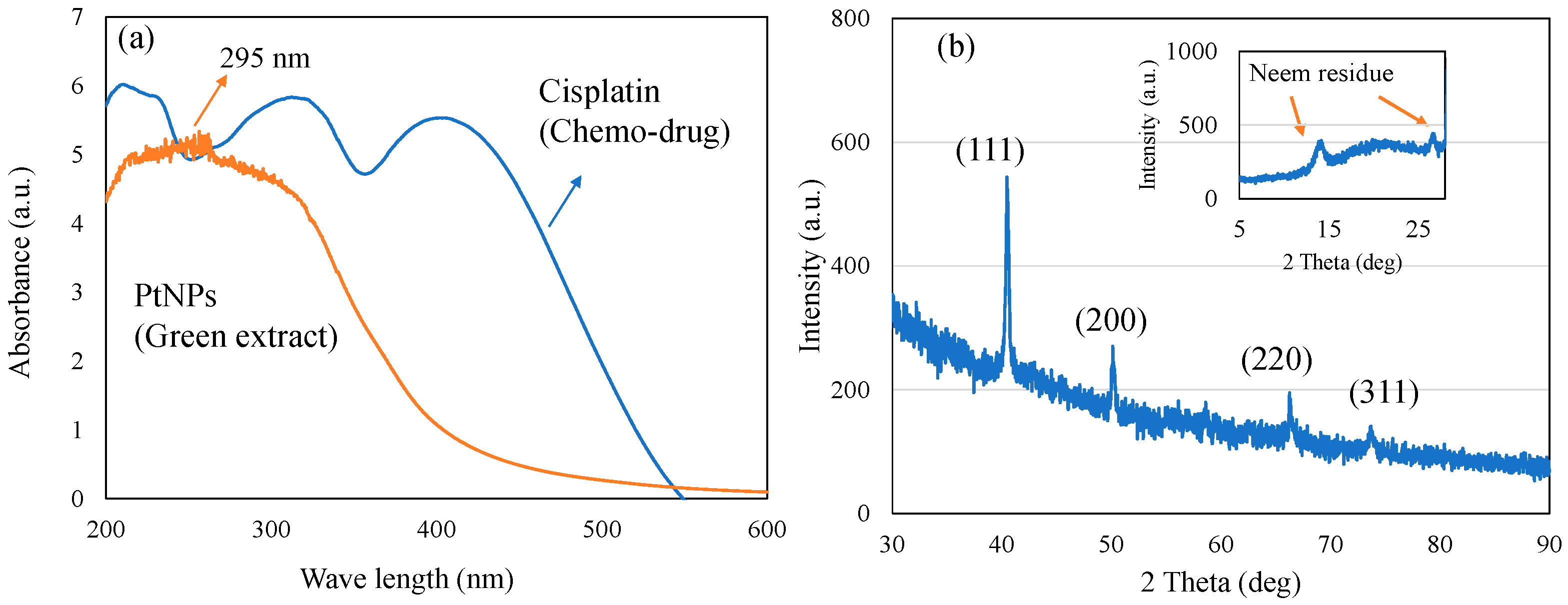
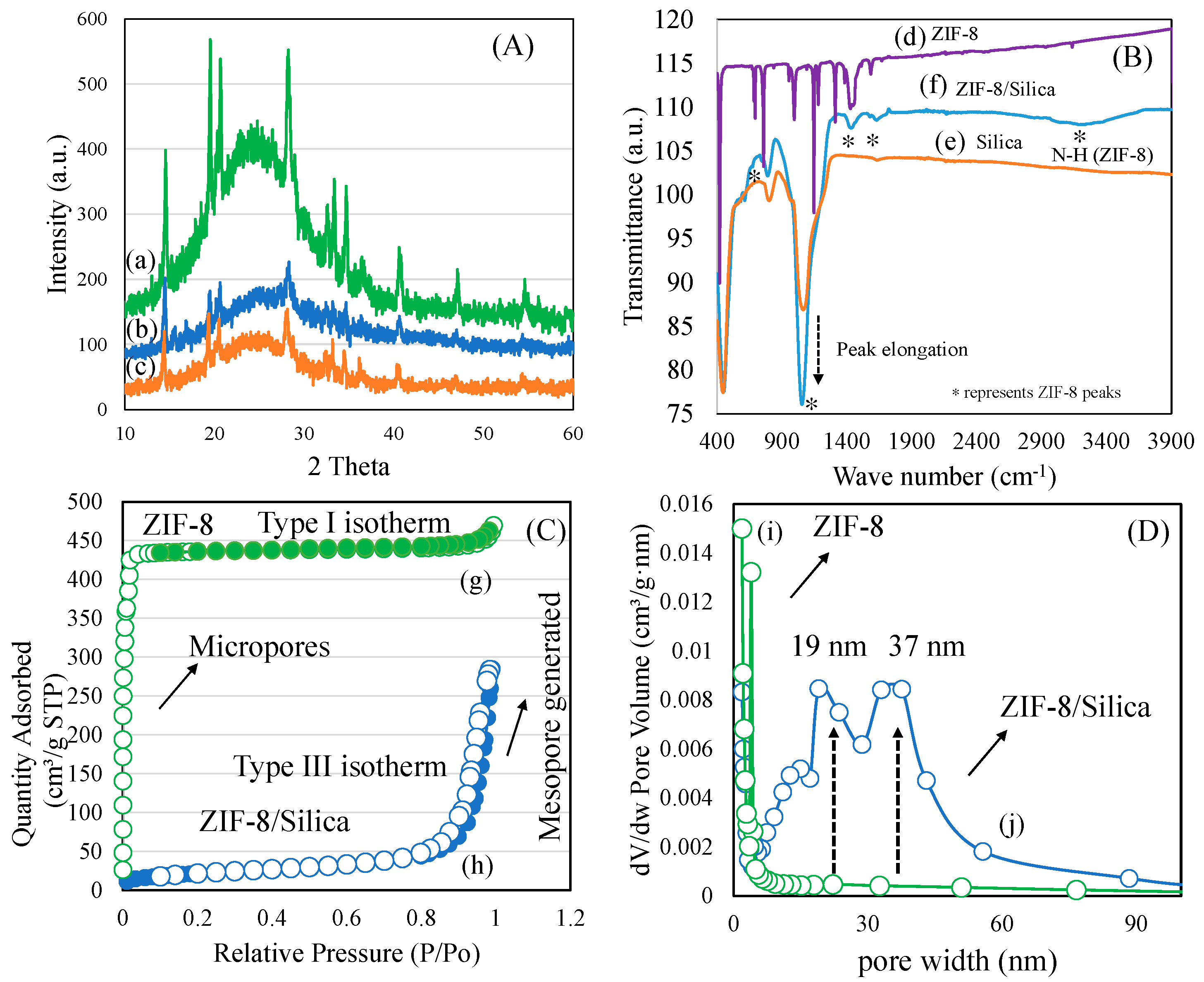
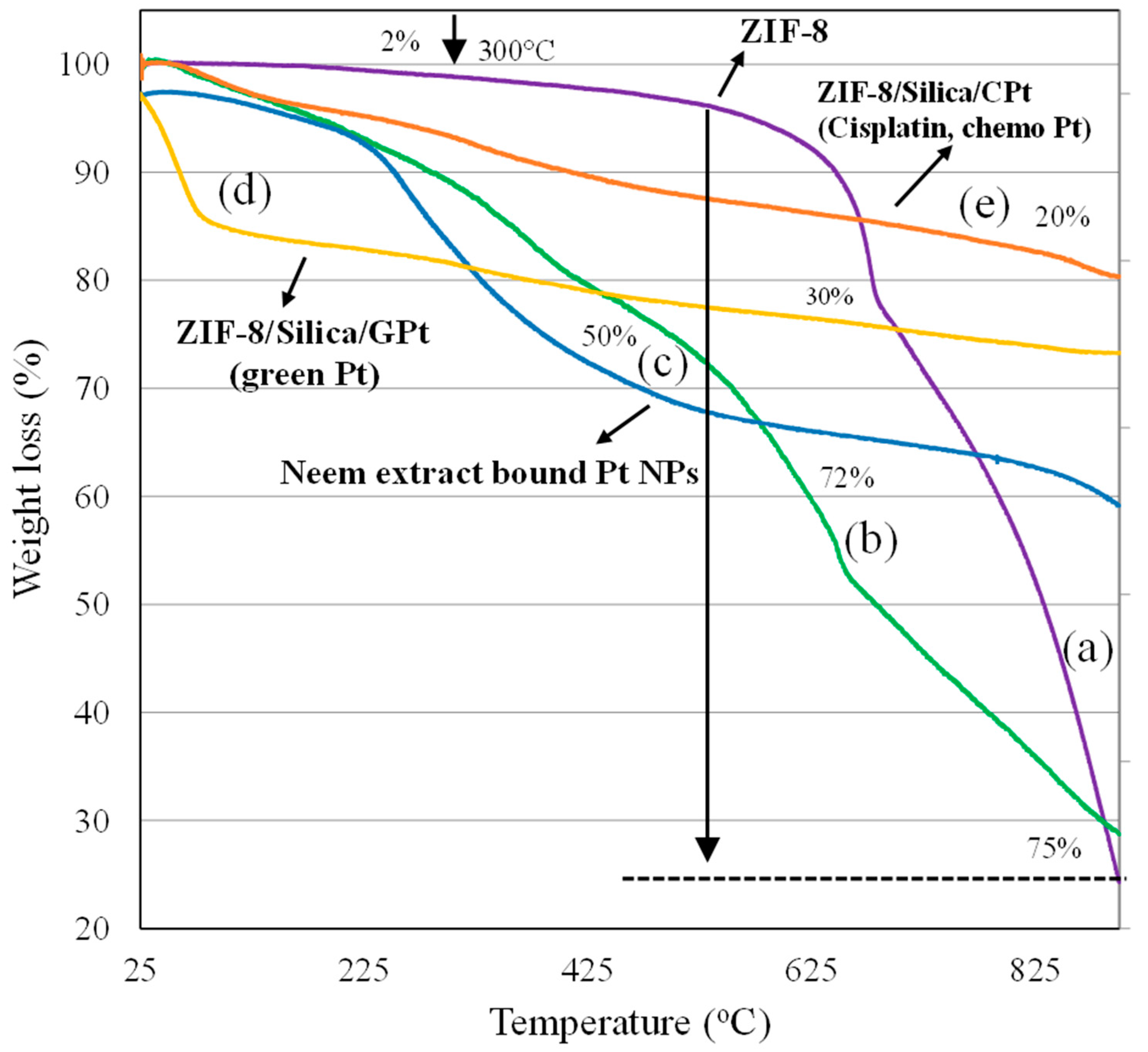
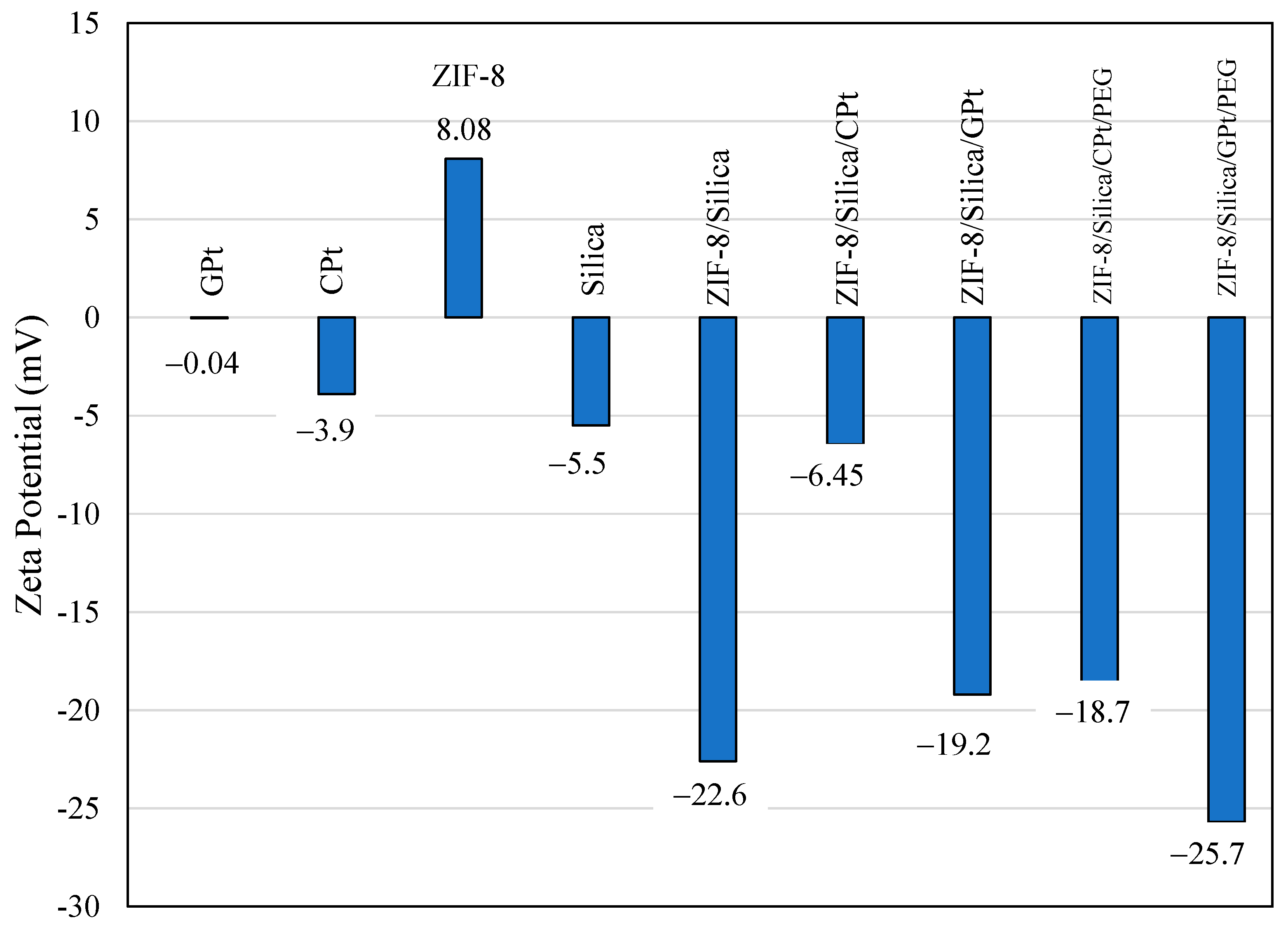
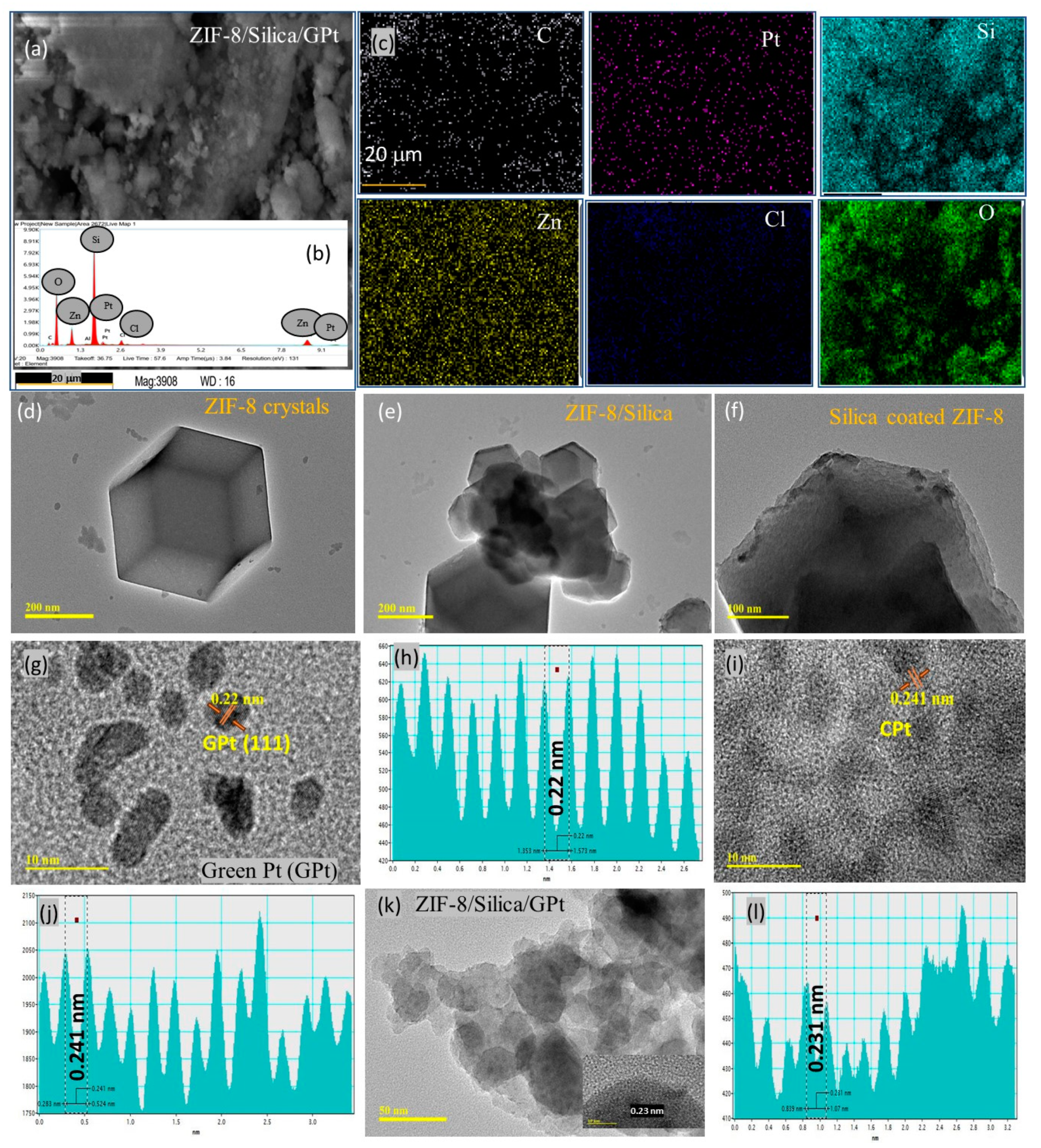
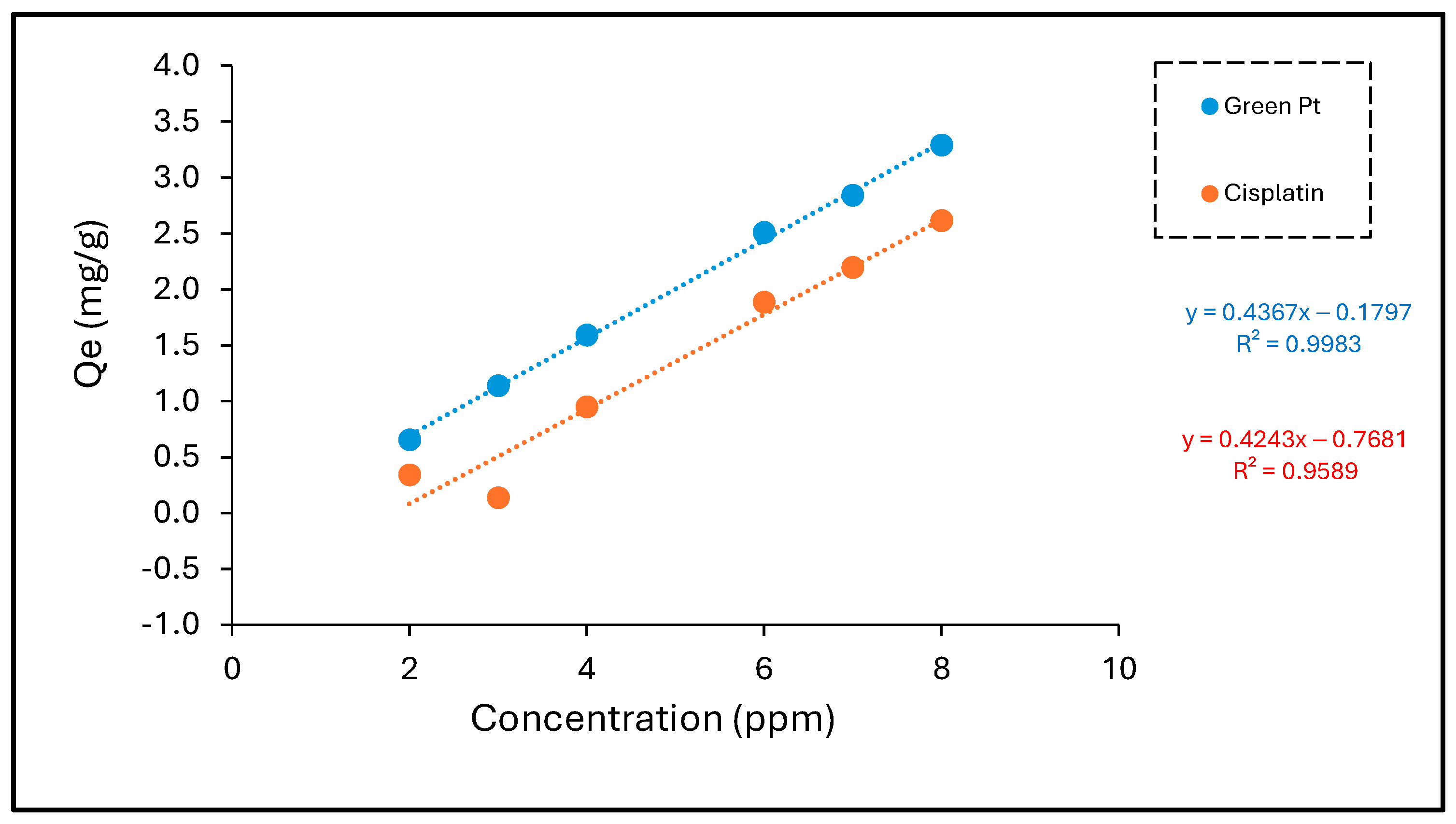

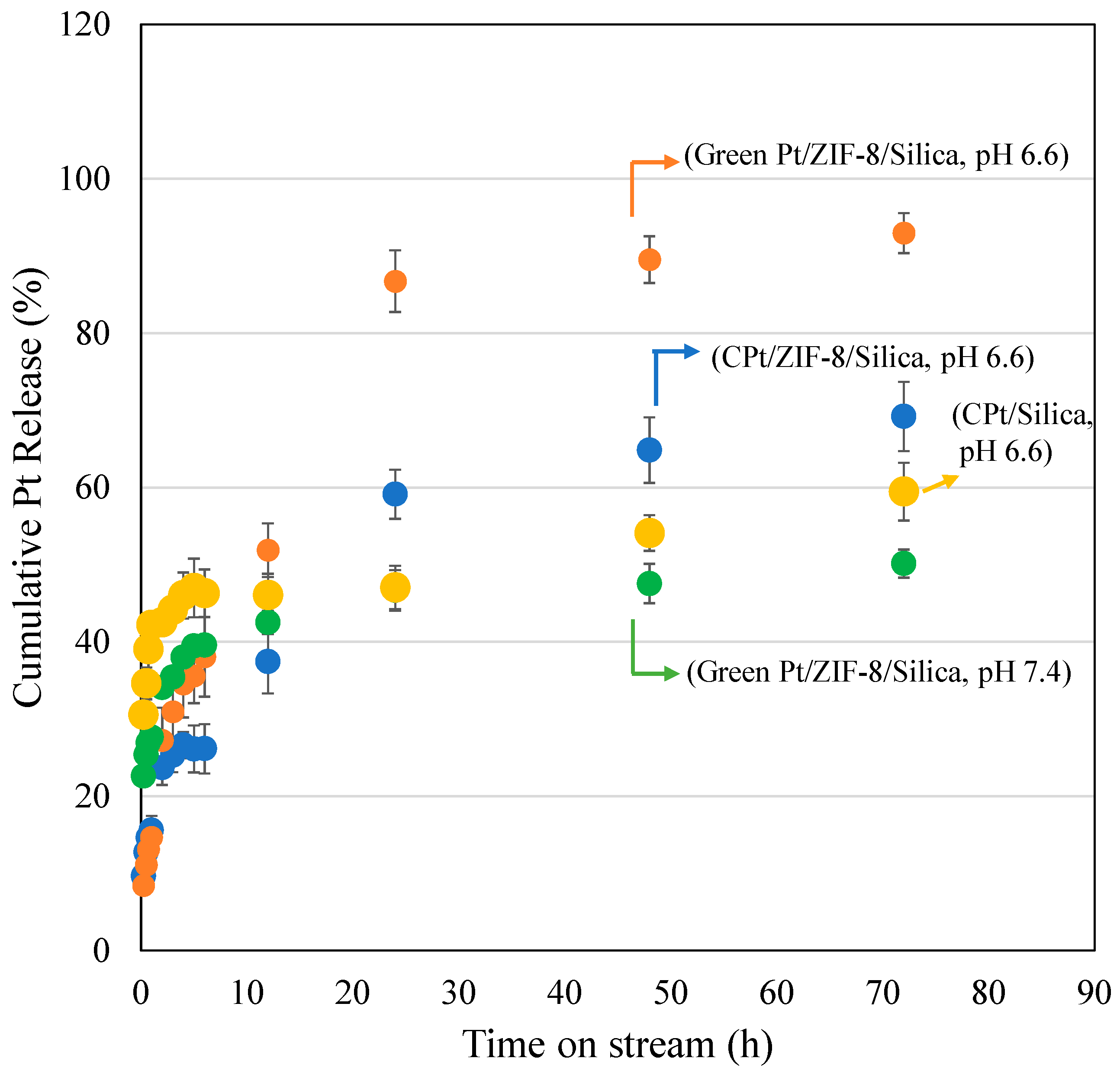

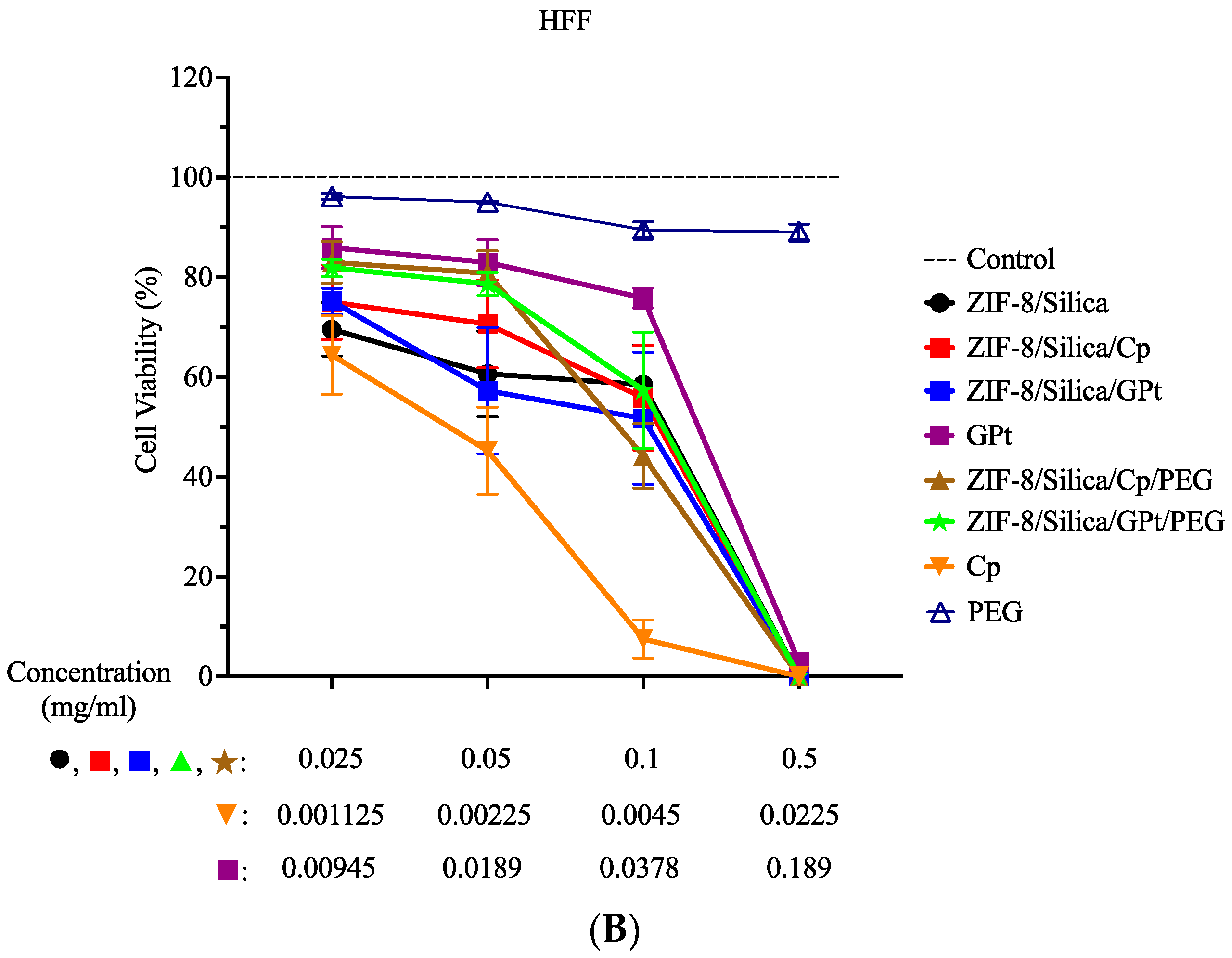

| Sample | BET Surface Area (m2/g) | t-Plot microSA (m2/g) | MesoSA (m2/g) | Pore Volume (cm3/g) | Pore Size (nm) |
|---|---|---|---|---|---|
| ZIF-8 | 1217 | 1182 | 35 | 0.72 | 2.3 |
| ZIF-8/Silica | 75 | - | 75 | 0.44 | 23.5 |
| C0 (ppm) | Green Pt | Removal Efficiency (%) | Cisplatin | Removal Efficiency (%) |
|---|---|---|---|---|
| Qe (mg/g) | Qe (mg/g) | |||
| 3 | 1.14 | 75.90 | 0.14 | 9.00 |
| 4 | 1.59 | 79.50 | 0.95 | 47.50 |
| 6 | 2.51 | 83.67 | 1.89 | 62.83 |
| 7 | 2.84 | 81.14 | 2.20 | 62.71 |
| 8 | 3.29 | 82.25 | 2.62 | 65.38 |
| Langmuir Model | Freundlich Model | Temkin Model | ||||||||
|---|---|---|---|---|---|---|---|---|---|---|
| q0 (mg/g) | KL (L/mg) | RL (L/mg) | R2 | Kf (mg/g) | n | R2 | B (J/mol) | A (L/g) | R2 | |
| Green Pt | 90.909 | 0.090 | 0.356 | 0.912 | 2.265 | 0.964 | 0.985 | 16.899 | 1.296 | 0.953 |
| Cisplatin | 294.117 | 0.106 | 0.318 | 0.867 | 0.081 | 2.871 | 0.787 | 15.160 | 1.174 | 0.939 |
| Treatment Group | EC50 µg/mL | |
|---|---|---|
| MCF7 | HFF | |
| ZIF-8/Silica | 83.04 | 82.02 |
| ZIF-8/Silica/Cp | 39.72 | 94.01 |
| ZIF-8/Silica/GPt | 62.11 | 75.05 |
| ZIF-8/Silica/Cp/PEG | 94.86 | 90.06 |
| ZIF-8/Silica/GPt/PEG | 60.19 | 107.6 |
| Cp | 2.849 | 1.965 |
| GPt | 31.47 | 55.09 |
Disclaimer/Publisher’s Note: The statements, opinions and data contained in all publications are solely those of the individual author(s) and contributor(s) and not of MDPI and/or the editor(s). MDPI and/or the editor(s) disclaim responsibility for any injury to people or property resulting from any ideas, methods, instructions or products referred to in the content. |
© 2024 by the authors. Licensee MDPI, Basel, Switzerland. This article is an open access article distributed under the terms and conditions of the Creative Commons Attribution (CC BY) license (https://creativecommons.org/licenses/by/4.0/).
Share and Cite
Alotaibi, H.G.; Al-Abbad, E.; Almohazey, D.; Ravinayagam, V.; Akhtar, S.; Dafalla, H.; Jermy, B.R. Zeolitic Imidazole Framework/Silica Nanocomposite for Targeted Cancer Therapeutics: Comparative Study of Chemo-Drug Cisplatin (CPt) and Green Platinum (GPt) Efficacy. Int. J. Mol. Sci. 2024, 25, 3157. https://doi.org/10.3390/ijms25063157
Alotaibi HG, Al-Abbad E, Almohazey D, Ravinayagam V, Akhtar S, Dafalla H, Jermy BR. Zeolitic Imidazole Framework/Silica Nanocomposite for Targeted Cancer Therapeutics: Comparative Study of Chemo-Drug Cisplatin (CPt) and Green Platinum (GPt) Efficacy. International Journal of Molecular Sciences. 2024; 25(6):3157. https://doi.org/10.3390/ijms25063157
Chicago/Turabian StyleAlotaibi, Hend Ghnaim, Eman Al-Abbad, Dana Almohazey, Vijaya Ravinayagam, Sultan Akhtar, Hatim Dafalla, and B. Rabindran Jermy. 2024. "Zeolitic Imidazole Framework/Silica Nanocomposite for Targeted Cancer Therapeutics: Comparative Study of Chemo-Drug Cisplatin (CPt) and Green Platinum (GPt) Efficacy" International Journal of Molecular Sciences 25, no. 6: 3157. https://doi.org/10.3390/ijms25063157
APA StyleAlotaibi, H. G., Al-Abbad, E., Almohazey, D., Ravinayagam, V., Akhtar, S., Dafalla, H., & Jermy, B. R. (2024). Zeolitic Imidazole Framework/Silica Nanocomposite for Targeted Cancer Therapeutics: Comparative Study of Chemo-Drug Cisplatin (CPt) and Green Platinum (GPt) Efficacy. International Journal of Molecular Sciences, 25(6), 3157. https://doi.org/10.3390/ijms25063157







